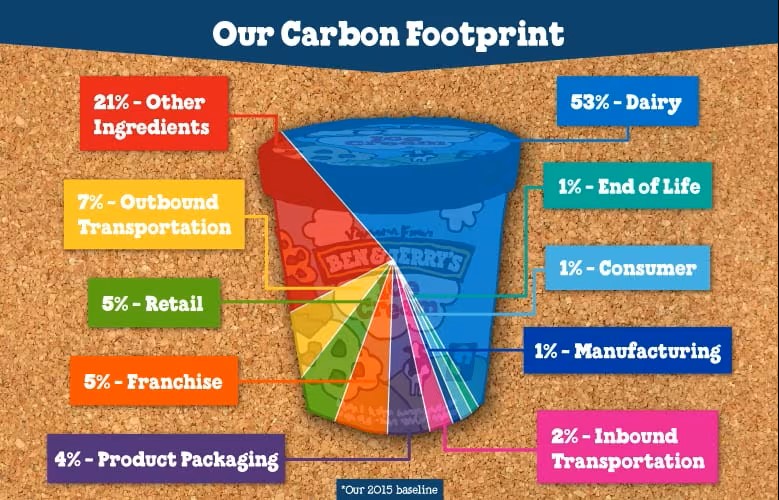Ben & Jerry’s: A Scoop of Sustainability and Social Responsibility”
The purpose of Ben & Jerry’s advertisement is to promote their line of ice cream products, with a focus on their environmental impact reduction and commitment to sustainable packaging. The format of the advertisement is still images (“Ben and Jerry” 2023). They are carrying out sustainable packaging so they can minimize their environmental effects. By 2025, the company wants its packaging to be recyclable compostable, and free from plastic based. For instance, they have already made great progress, such as switching to paper wrappers and plant based biodegradable packaging so it can reduce the single use of plastic packaging produced by petroleum to have eco-friendly packaging which won’t affect environment.
And the picture which I used in the advertisement is the graphic, a pie chart, cleverly uses a picture of a pint of Ben & Jerry’s ice cream to illustrate the company’s carbon footprint. The graphic, titled “Our Carbon Footprint,” is divided into sections that correspond to several elements, including dairy, additional ingredients, retail, franchising, manufacturing, product packaging, and customer impact. The percentage of each segment is shown by color-coding, with red, blue, green, orange, purple, and so on being especially focused on packaging. The pie chart takes up most of the image’s composition, which is essentially side to side. The Ben & Jerry’s ice cream pint illustration serves as a unique and eye-catching element to artistically convey the information, while the pie chart itself is the main subject. The image’s background is a cork board, suggesting an office or educational situation. The image quality seems to be realistic and clear, guaranteeing that the pie chart is represented in a way that is understandable. The use of the ice cream pint illustration, which offers a novel and captivating method of communicating complex data regarding the company’s carbon impact, is the most remarkable aspect of the visual elements.
The advertisement’s main point is Ben & Jerry’s dedication to environmentally and socially conscious business methods. This message is probably communicated by images, such as pictures of eco-friendly packaging, eco-friendly production techniques, and community involvement. For buyers who value ecological and socially conscious products will likely find the image appealing, it is probably effective in reaching the intended demographic. Using images that highlight eco-friendly operations and community involvement could be a powerful way for the brand to convey its dedication to ethical business practices. Overall, the viewer may experience a positive influence that builds brand loyalty and trust.
I am quite familiar with this brand because Ben & Jerry’s is highly known for its commitment to social and environmental responsibility. The references that are put in, including sustainability reports, show reducing their carbon footprint and promoting sustainable packaging as two of their main environmental goals. By 2025, the packaging of the cream will be recyclable, compostable, and free of petroleum-based plastic. Also, they have already started doing so by reducing the use of plastic straws and spoons from their Shops and switch to more environmentally friendly paper wrappers, or use of plant-based and compostable packaging so it can decompose easily, the company has made great progress (“Sustainable Packaging” 2024). As its dairy components play a major role in their carbon footprint, and are addressing this by experimenting with regenerative agriculture techniques and altering the diets of their cows. As to complete their target by 2050, emissions intensity will be reduced by 80% and 40%, respectively. To accomplish these goals, they prioritize sourcing, portfolio innovation, and manufacturing processes while emphasizing responsibility through quantifiable benchmarks. This highlights the necessity of moving quickly towards a clean-energy economy and calls for coordinated action to tackle climate change. Renowned ice cream manufacturer Ben & Jerry’s is dedicated to combating climate change via social responsibility and sustainable operations. The also intends to reduce greenhouse gas emissions from dairy by more than 50% over the next ten years, acknowledging the impact of the climate crisis on its products, which include coffee, vanilla, and chocolate. They concentrate on methods like applying regenerative farming techniques, creative feeds, and manure digesters. Furthermore, they have decided to give a greater impact on ecofriendly sustainable packaging which is 100% free of plastic by 2025. The company emphasizes environmentally friendly technology and is a pioneer in the usage of Cleaner Greener Freezers. To ensure fair remuneration for smallholder farmers impacted by climate change, Ben & Jerry’s also supports Fairtrade. The company actively supports marginalized communities and works with a global movement in climate justice initiatives. Ben & Jerry’s dedication to sustainability and social justice elevates the company’s identity, branding, and reputation, positioning it as an ecologically sensitive and socially responsible enterprise.
Biblography
Sustainable Packaging. Ben & Jerry’s. 2023. Accessed January 25, 2024 https://www.benjerry.com/values/how-we-do-business/sustainable-packaging.
Our Climate Impact & What We’re Doing to Reduce It. Ben & Jerry’s.2023. Accessed January
25, 2024
https://www.benjerry.com/values/issues-we-care-about/our-climate-impact.
Ben & Jerry’s. “Ben & Jerry’s Is Fighting for Climate Justice, One Scoop at a Time.” Ben & Jerry’s. Accessed January 26, 2024. https://www.benjerry.com/whats-new/2021/10/ben-jerrys-fighting-for-climate-justice.
Kgasa, Nikita. “Green Marketing: Ben & Jerry’s.” Prezi. Last modified May 6, 2015.
https://prezi.com/aj5frfhqacg0/green-marketing-ben-jerrys/.


Provide Feedback